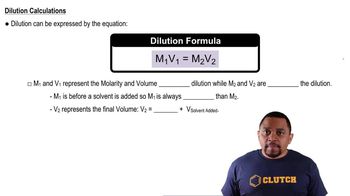Potassium superoxide, KO2, is often used in oxygen masks (such as those used by firefighters) because KO2 reacts with CO2 to release molecular oxygen. Experiments indicate that 2 mol of KO2(s) react with each mole of CO2(g). (b) Indicate the oxidation number for each atom involved in the reaction in part (a). What elements are being oxidized and reduced?
Ch.4 - Reactions in Aqueous Solution
Chapter 4, Problem 115a
Federal regulations set an upper limit of 50 parts per million (ppm) of NH3 in the air in a work environment [that is, 50 molecules of NH3(g) for every million molecules in the air]. Air from a manufacturing operation was drawn through a solution containing 1.00⨉102 mL of 0.0105 M HCl. The NH3 reacts with HCl according to: NH3(aq) + HCl(aq) → NH4Cl(aq). After drawing air through the acid solution for 10.0 min at a rate of 10.0 L/min, the acid was titrated. The remaining acid needed 13.1 mL of 0.0588 M NaOH to reach the equivalence point. (a) How many grams of NH3 were drawn into the acid solution?
 Verified step by step guidance
Verified step by step guidance1
Calculate the total volume of air drawn through the solution: \(10.0 \text{ L/min} \times 10.0 \text{ min} = 100.0 \text{ L}\).
Determine the initial moles of HCl in the solution: \(0.0105 \text{ M} \times 0.100 \text{ L} = 0.00105 \text{ mol HCl}\).
Calculate the moles of NaOH used in the titration: \(0.0588 \text{ M} \times 0.0131 \text{ L} = 0.00076968 \text{ mol NaOH}\).
Determine the moles of HCl that reacted with NH\(_3\) by subtracting the moles of NaOH from the initial moles of HCl: \(0.00105 \text{ mol} - 0.00076968 \text{ mol} = 0.00028032 \text{ mol HCl reacted}\).
Convert the moles of NH\(_3\) to grams using the molar mass of NH\(_3\) (17.03 g/mol): \(0.00028032 \text{ mol} \times 17.03 \text{ g/mol}\).

Verified video answer for a similar problem:
This video solution was recommended by our tutors as helpful for the problem above.
Video duration:
3mWas this helpful?
Key Concepts
Here are the essential concepts you must grasp in order to answer the question correctly.
Stoichiometry
Stoichiometry is the calculation of reactants and products in chemical reactions based on the balanced chemical equation. It allows us to determine the amount of substances consumed or produced in a reaction. In this case, understanding the stoichiometric relationship between NH<sub>3</sub> and HCl is crucial for calculating how much NH<sub>3</sub> reacted with the acid.
Recommended video:
Guided course

Stoichiometry Concept
Molarity and Dilution
Molarity (M) is a measure of concentration defined as moles of solute per liter of solution. In this problem, the concentration of HCl is given, and we need to use it to find the number of moles of HCl that reacted. Additionally, the dilution of HCl after the reaction with NH<sub>3</sub> will be important for determining how much acid remains, which can be used to find the amount of NH<sub>3</sub> that was absorbed.
Recommended video:
Guided course

Dilution Equation
Titration
Titration is a laboratory technique used to determine the concentration of a solute in a solution by reacting it with a reagent of known concentration. In this scenario, the remaining HCl after the reaction with NH<sub>3</sub> is titrated with NaOH to find out how much HCl was left, which helps in calculating the amount of NH<sub>3</sub> that reacted. The equivalence point in titration indicates that the amount of titrant added is stoichiometrically equivalent to the amount of substance being analyzed.
Recommended video:
Guided course

Acid-Base Titration
Related Practice
Textbook Question
Textbook Question
Federal regulations set an upper limit of 50 parts per million (ppm) of NH3 in the air in a work environment [that is, 50 molecules of NH3(g) for every million molecules in the air]. Air from a manufacturing operation was drawn through a solution containing 1.00⨉102 mL of 0.0105 M HCl. The NH3 reacts with HCl according to: NH3(aq) + HCl(aq) → NH4Cl(aq). After drawing air through the acid solution for 10.0 min at a rate of 10.0 L/min, the acid was titrated. The remaining acid needed 13.1 mL of 0.0588 M NaOH to reach the equivalence point. (b) How many ppm of NH3 were in the air? (Air has a density of 1.20 g/L and an average molar mass of 29.0 g/mol under the conditions of the experiment.)
Textbook Question
Chlorine dioxide gas 1ClO22 is used as a commercial bleachingagent. It bleaches materials by oxidizing them. In thecourse of these reactions, the ClO2 is itself reduced. (b) Why do you think that ClO2 is reduced so readily?
